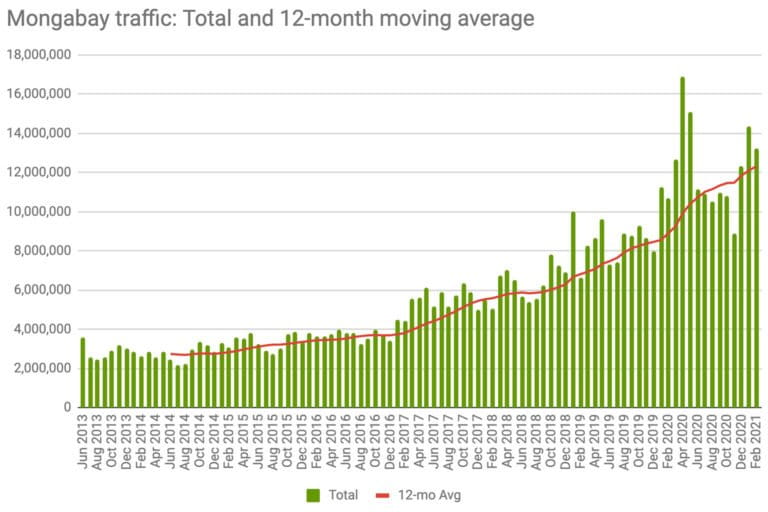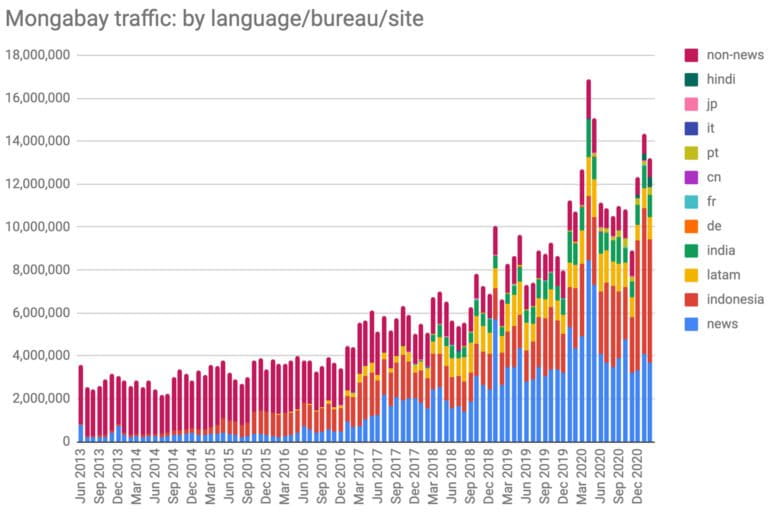- Mongabay’s most read post during the month of February on our global English news site was a story by John Cannon about the threat posted to Asia’s wild pig populations from African swine fever. The story was based on a paper published in the journal Conservation Letters.
- Overall, traffic across all of Mongabay’s bureaus amounted to 13.3 million pageviews, a 24% increase over a year ago.
- Below are the articles with the most traffic during the month of February.
Last month Mongabay’s readership was up 24% over a year earlier to 13.3 million pageviews. Aggregate time spent on these articles was up 300%.
The following are the most popular articles on news.mongabay.com during February 2021.
Note: the traffic data presented below is only for the month of February and therefore doesn’t include traffic in prior months for stories published earlier than February.
(12 Feb 2021) Written by John C. Cannon – 113,047 pageviews
- A recent study in the journal Conservation Letters warns that African swine fever, responsible for millions of pig deaths in mainland Asia since 2018, now endangers 11 wild pig species living in Southeast Asia.
- These pig species generally have low populations naturally, and their numbers have dwindled further due to hunting and loss of habitat.
- The authors of the study contend that losing these species could hurt local economies and food security.
- Southeast Asia’s wild pigs are also important ecosystem engineers that till the soil and encourage plant life, and they are prey for critically endangered predators such as the Sumatran tiger and the Javan leopard.

(27 Jan 2021) Written by Leilani Chavez – 106,356 pageviews
- Philippine pangolins, found only in the island province of Palawan, are among the most heavily trafficked mammals in the world, with nearly 7,000 seized from traffickers between 2018 and 2019.
- But unlike some populations of other pangolin species, the Philippine pangolin might have a chance of bouncing back if the appropriate conservation measures are set up to protect the species.
- A new study, which uses locals’ sightings and knowledge of the species, shows the Philippine pangolin is widely distributed across its range and knowledge of the species is high. However, sightings were either rare or very rare and declines were reported across the survey areas.
- The survey also showed a high level of willingness among communities to protect the species, suggesting that local conservation efforts may work, researchers say.
(04 Feb 2021) Written by James Fair – 75,604 pageviews
- The Tasmanian tiger, or thylacine, most likely went extinct in the late 1990s or early 2000s, and could still persist in the most remote parts of the island, according to new research that is still undergoing peer review.
- More than 1,200 records of sightings and physical evidence from 1910 up to 2019 were collected and collated by scientists at the University of Tasmania and used to model where and when the thylacine is likely to have persisted.
- This study challenges the accepted consensus that the thylacine went extinct in the decade or two after the last known individual died in Hobart Zoo in 1936.
- The authors say they believe their novel method for using citizen science could be applied to help find other species either believed to be extinct or known to be extremely rare.

(04 Feb 2021) Written by Teresa L. Carey – 67,888 pageviews
- In January scientists announced the designation of a new whale species in the Gulf of Mexico they named Rice’s whale (Balaenoptera ricei).
- The team previously collected genetic samples of the whales but didn’t confirm the new species until they had a complete skeleton.
- Only between 33 and 100 individual members of the species exist, researchers estimate. The species is listed as endangered in the U.S.
- The Gulf of Mexico is fraught with many human-made threats to the whales’ survival, including dense ship traffic, oil and gas exploration, and marine trash.
(02 Feb 2021) Written by Hans Nicholas Jong – 58,646 pageviews
- Illegal loggers in Indonesia continue to go largely unpunished because of a weak judicial system and loopholes in timber regulations, according to a new report.
- The report by investigative NGOs EIA and Kaoem Telapak looked at law enforcement actions against more than 50 companies, most of them found to be trading in illegally logged merbau, a prized tropical hardwood, but evading prosecution.
- The few companies and individuals prosecuted and found guilty in court were still allowed to operate and even retain their certificates of timber legality — a stamp of approval that allows them to export the illegally logged wood.
- In one case, Indonesia’s highest court overturned a lower court’s judgment against a convicted merbau trafficker, ordering the authorities to give him back the stockpile of illegal timber they had seized from him.
(22 Jan 2021) Written by Mongabay.com – 52,353 pageviews
- In Sumatra, elephants’ forested habitat has been replaced recently at a rapid pace for commercial activities like oil palm plantations, pulp and paper production, and other uses.
- The total Sumatran elephant population was estimated to be no more than 2,800 individuals in 2007, but they likely number about half that now.
- It’s been said that there’s just 10 years left to save this critically endangered species, and experts that Mongabay spoke with say that this is probably optimistic: however, taking the meaningful actions they suggest could succeed during that time and would have additional benefits for other wildlife plus human communities, too.
- This podcast is the latest in the Mongabay Explores series, taking a deep dive into the fascinating wildlife and complicated conservation issues of this giant Indonesian island.

(13 Jan 2021) Written by Ian Morse – 51,137 pageviews
- Volunteers and officials successfully pushed a whale shark back out to sea after it got stranded in shallow water in Indonesia’s Kendari Bay.
- The incident, which one rescuer said was a first, has highlighted the consequences of the rapid silting of the bay amid a spate of development projects in the area.
- The clearing of land allows dirt to run into waterways, with the accumulated sediment halving the depth of Kendari Bay and making flood prevention more difficult.
- Amid the silting, fishing catches have declined and there are indications of heavy-metal contamination of the water.
(28 Jan 2021) Written by Tri Purna Jaya – 44,836 pageviews
- The wild Sumatran rhinos of Way Kambas National Park in Indonesia are becoming even more elusive in response to changes to their habitat, according to rhino expert Arief Rubianto.
- Fires and poaching of other species for bushmeat pose a serious threat to the critically endangered rhinos.
- Way Kambas is believed to be one of the last strongholds of the Sumatran rhino, with estimates of 12 to 33 wild rhinos, out of a global population of less than 80.
- Indonesian officials and conservationists are carrying out a census to get a better idea of the species’ true population to help inform conservation strategies.
(20 Jan 2021) Written by Genevieve Belmaker – 43,047 pageviews
- After years of research, economics experts say they can prove that financial markets respond swiftly and definitively when multinationals are publicly named in connection with the assassination of an environmental defender.
- The researchers analyzed 354 assassinations over two decades connected to mining and extractive minerals projects around the world, noting particularly significant violent action in the Philippines and Peru.
- Once a company is named, the data show that within 10 days the markets respond, hitting the company with a median loss in market capitalization of more than $100 million.
"popular" - Google News
March 08, 2021 at 11:29PM
https://ift.tt/3v78BEY
Mongabay's most popular posts in February 2021 - Mongabay.com
"popular" - Google News
https://ift.tt/33ETcgo
Shoes Man Tutorial
Pos News Update
Meme Update
Korean Entertainment News
Japan News Update
Bagikan Berita Ini

















0 Response to "Mongabay's most popular posts in February 2021 - Mongabay.com"
Posting Komentar